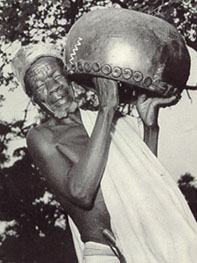

Introduction | Introductoy History | Mbira Music | The Bira and the N'anga | Learning the Mbira | Constraint and Mobility | Conclusion | End Notes | Bibliography
As a member of a culture that pushes music to the background and uses it as a mood enhancer, it is refreshing to approach a culture that tries to grasp the full power of music. The United States claims itself as musical mecca of the world: it is the mother of blues and jazz, it is the residence of some of the most famous symphonies in the world, and our popular musicians are also the ones topping charts in foreign countries. But for all these credentials, America is also the home of smooth jazz and light rock that comprise the ever-pervading category of muzak. In nearly every elevator, every store, and every restaurant in America, proprietors pump in soothing music to lighten the mood and to keep people from thinking. What have we done to music? America dilutes music to a point where it becomes meaningless; America no longer pays attention to music. And in this era of numbness, especially with alcohol, drugs, and prescription drugs(1), does our music perhaps indicate something about our culture? So one can imagine how inspiring it was to encounter the Shona people of Zimbabwe, where their mbira(2) music stands at the forefront not only as a symbol of the past(3) but also as the primary connection between the living and the dead. Just as American music is telling of American society, much can be learned about the Shona from their mbira music.

The music tells much: it is a complex and cyclical music, full of texture and overlapping
rhythms. When listening closely, it has the potential to be profoundly meditative music. It has an
incredibly enchanting and majestical quality to it. Observations like these can lead to insights into
the society, for example, what use does the music's meditative quality have in the society? But
learning about a society simply from listening to the music would be stopping too short. There
exist a multitude of factors surrounding music that play an equally important, if not more
important, role in releasing information about a society. One must also consider who plays the
music, the repertoire of music played, where the music is played, how the music is passed on, how
one learns the instrument, and many more. After coming to some conclusions on what mbira
music reveals about Shona society, I compared my conclusions to other authors' views of the
Shona. While many of the conclusions are similar, our stands are strikingly different concerning
constraint and mobility in Shona society. Much of the literature (primarily Michael Gelfand)
portray Shona as obsessed with tradition and ancestors to the point of constraining themselves in
time. When written about, authors illustrate the Shona as a very rigid, anti-progressive society.
But through a look at Shona mbira music, the case will be made that this theme of rigidness and
obsession with tradition is taken too far. While the society and music are steeped in tradition,
both are open and accepting to variation, newness, and change. Mbira is one of the most
traditional musics that exist, but it still relies heavily on variation and change. The same holds
true for Shona society. To claim that they don't change or evolve is ridiculous. A cursory glance
at their response to colonialism would refute this. It is not only unfair, but it is incorrect to label
the Shona as an anti-progressive society.
Introductory History(4)
Introduction | Mbira Music | The Bira and the N'anga | Learning the Mbira | Constraint and Mobility | Conclusion | End Notes | Bibliography
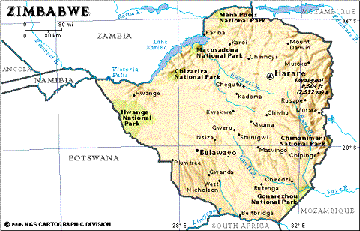
|
The Shona make up three-quarters of the population of Zimbabwe, while the remaining southwestern portion of the country is primarily made up of the Nguni-speaking Ndebele (Murray 196). The country now known as Zimbabwe, constrained by the Zambezi river to the north, the Limpopo River to the south, the Eastern Highlands range to the east, and Botswana to the west, has been the home of the Shona for many years. In the twelfth century, Shona built in stone, during the thirteenth to fifteenth centuries, the kingdom of Great Zimbabwe emerged, during the mid-fifteenth century, the Munhumutapa(5) empire arose, and after this empire was overrun by the Changamire(6), hundreds of small Shona states became the primary form of political organization. |
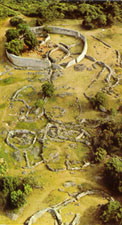 |
Beginning in 1890 and continuing until 1897, Cecil Rhodes's British South Africa Company (BSAC) colonized the area(7), and in May of 1895, the area officially became known as Rhodesia(8). After independence from British colonial rule in 1980, the country took its name from one of the greatest achievements in African history, a distinct part of its past. "Zimbabwe" means stone dwelling(9), and the great collection of huge stone walls and palaces built from twelve hundred to about fourteen-fifty AD became known as "Great Zimbabwe." The fact that the country took its name from a period in its past is important. It stresses the importance of their history and the people who came before them, their ancestors. Naming the country Zimbabwe was also afrocentric in that it emphasized their African past and not their white, colonial past. | 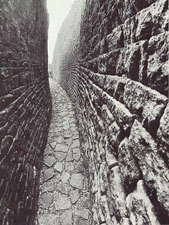 |
Mbira Music Introduction | Introductoy History | The Bira and the N'anga | Learning the Mbira | Constraint and Mobility | Conclusion | End Notes | Bibliography
The history of the mbira, often Americanized into a "thumb piano," is thought by some to run through all the aforementioned Shona societies. The mbira is firmly rooted in African mythology(10) and is thought to have been with the Shona for more than one thousand years(11). The mbira can be found in much of the historical literature of the Shona. It is mentioned as part of the sixteenth century court of Munhumutapa and as a part of Shona military culture (Berliner 42). The mbira is also praised heavily in Shona stories. Some accounts grant players of the mbira invincibility, some praise the mbira for its power to sooth the nerves (i.e., during a fierce storm), and others laud its power to calm wild animals of the African jungle (Berliner 48-9).
|
The mbira can be found across Africa with a number of different names, such as sanzhi, likembe, and kalimba(12), but its construction is always fundamentally the same. The mbira consists of "hand-forged, tuned metal keys bound to a wooden sound-board"(13) called a gwariva(14). Usually, it also has some method of amplifying the sound (often a hollowed, dried gourd) and items to create the characteristic buzzing sound (metal beads, snail shells, and recently, bottle caps)(15). [Click to hear an example.] The mbira can be found in different shapes and sizes across the country, but the most traditional one (the only one solely associated with religious worship and the only one to solely originate from Zimbabwe(16)) is the mbira dzavadzimu (vadzimu means ancestors; the mbira of the ancestors). The mbira dzavadzimu |
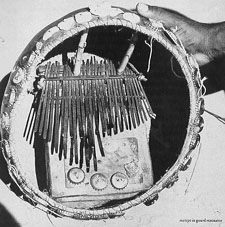
|
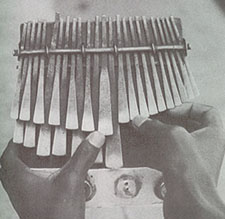 | usually consists of twenty-two spatulate keys . . . The keys are mounted on three manuals, two on the left and one on the right, on a tray-shaped soundboard with a finger hole in the lower right corner. The little finger of the right hand is inserted into the hole from the front of the mbira and helps to support the instrument while playing . . . The left bottom manual is the lowest register, the left upper manual contains pitches of a middle range, and the highest are played on the right manual . . . only three fingers are used; the left thumb plays both manuals of keys on the left side of the mbira, while the right thumb plays the first inside three keys and the right index finger plays the outer six on the right manual . . . the thumbs pluck downward from above and the index finger plucks upward from underneath the keys.(17) |
The repertoire of mbira dzavadzimu players consists of primarily traditional songs that have been passed down orally and are meant for religious ritual. Pieces such as "Nyamaropa," "Muka tiende," and "Nhemamusasa" are thought to have been with the mbira dzavadzimu since its beginnings. The pieces can be broken up into two parts: the kushaura and the kutsinhira. The kushaura is the lead part, or the solo part; if there is only one player at a ceremony, the player will play the kushaura. The kutsinhira is the part that weaves through the kushaura. It doesn't mimic the lead, it responds and plays off the lead.(18) It creates the texture that makes two mbira players sound like a large ensemble. Polyrhythms are beginning to become a cliche for African music, but the complex and multiple rhythms of mbira music create the large entity of texture and complexity that make this "meditative" music. The kushaura and kutsinhira parts can also be seen as "call and response" patterns. The kutsinhira is responding to the lead voice of the kushaura. It thinks about what the kushaura has to say and develops a response.
|
The constant buzz of the shells or bottle caps also contribute to this picture of complexity. The buzz has become a hallmark of mbira music because of the dimension it adds. Berliner sees the buzz "as analogous to the mist that partly obscures the mountains and small figures of certain Chinese silk-screen painting." They establish "mood and feeling" (11). The rising mbira star Forward Kwenda notes that "the buzz adds depth and context to the clear tones of the mbira keys, and may be heard as whispering voices, singing, tapping, knocking, wind or rain" (Kwenda 2). | 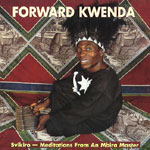 |
Since mbira music is religious music, it must be played at Shona mapira (plural for bira). The music must be continuous and must last through the night, so mbira music is cyclical: a single piece can be played for as long as wished. The pieces are forty-eight beat patterns and are split into four sections of twelve. The effect of this on African American music is undoubtable. Blues and jazz songs are usually twelve measure patterns (forty-eight beats = twelve measures, in 4/4 time(19)). Furthermore, the song is often broken down into four sections of twelve measures each, equaling a total of forty-eight measures (AABA is the common form: the A section is the melody or "head" and the B section is the "bridge"). The cycle of the music and the variations that occur each time are what help to create this textured, complex, meditative sound.
Berliner also gives credit to overtones for producing the "large" sound (69). Overtones are notes that are sounded in addition to notes that are played. It is possible to tune the keys to produce an additional sound that is a fifth or a third above the original pitch. John Kunaka, a master builder of mbira and player, says "he 'gives two voices' to the lowest pitch" (69). The overtones add additional sound and give the mbira a richer, more complex voice.
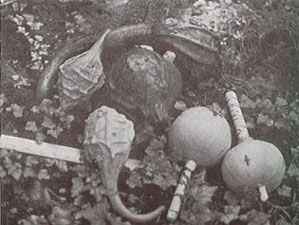 | While the mbira can be an effective solo instrument, [listen to Forward Kwenda solo] it is rarely found by itself at traditional Shona religious ceremonies. It is ordinarily accompanied by hosho players, handclapping, and singing. Hosho are dried gourds containing some sort of material to make the rattling sound, usually corn seeds or kernels. Hosho players are an important part of the group because they are responsible for setting and maintaining the tempo of the piece. In addition, those with the ability and skill to play through the night without breaks are in high demand. Handclapping patterns, called makwa, supplied by the villagers, also add additional rhythm. Berliner notes that the "makwa patterns combine in many ways and usually participants perform at least two contrasting patters simultaneously" (114). |
|
The final ingredient in this dense, interweaving music is the addition of singing. The mbira players and villagers perform in three singing styles: mahon'era(20), huro, and kudeketera(21). The mahon'era style is exclusively in the lower registers of the singers. It is a soft, low style of singing that uses syllables instead of words. "Hiya--hiya--hiya" is a common example of mahon'era singing (Berliner 116-7). [listen to an example]The huro style is in direct contrast with mahon'era: it is sung in the upper registers and utilizes melodic lines. Berliner points out that one of the forms of huro is "a highly developed form of yodelling (kunguridzira)" (117). The final style, kudeketera, is a verbal style that draws from Shona poetry and improvised texts (Berliner 121). [listen to an example] Kudeketera is important because it includes "references to history, proverbs, social and political commentary, activity of participants in the bira, praise of family members or ancestors, or other allusions to events in the experiences of those participating and to common troubles" (Berliner 174). Pamela Reynolds (Traditional Healers and Childhood in Zimbabwe) talks about how ritual brings things into the open. Ritual exposes problems, and once they are exposed, they must be dealt with. Kudeketera brings items of concern to the forefront and once there, they will be dealt with. Its importance in social terms is incalculable. | 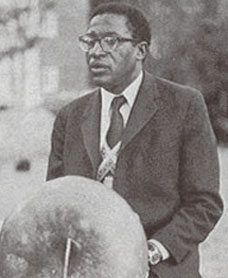 |
The Bira and the N'anga(22) Introduction | Introductoy History | Mbira Music | Learning the Mbira | Constraint and Mobility | Conclusion | End Notes | Bibliography
 | Yes, mbira music does function as entertaining music, but its main functions are more important. First, mbira music is an essential element at rain-making ceremonies, known as mukwerera(23). Fifteen to twenty mbira players gather along with villagers to call to the rain-making spirits (Berliner 187). This strong need for rain is indicative of an important aspect of Shona society: they have a strong reliance on agriculture and are primarily agriculturalists. Secondly, and more important, the mbira is used at a traditional, formal, all-night ceremony known as a bira. It is at a bira where a family comes together, because of a problem afflicting a member of the family, to call upon the help of ancestors. At a bira, the mbira serves as the "link between the world of the living and the world of the spirits" (Berliner 43). |
| When ill fortune arises in a family, such as sickness, a bad crop harvest, or death, the family will go to a n'anga(24) to seek advice. The n'anga's role and importance in society have been open to some debate(25), but they are generally accepted to be a major force in Shona culture and are relied upon in many ways. Most n'anga believe they are possessed by a healing spirit which enables them to help others (Gelfand, 1964, 27). With this acquired knowledge from the healing spirit, they are able to collect herbs and use charms to cure the sick. But it is when the herbs, charms, and other medicines do not work, that the Shona know something is seriously wrong. When these cures fail and the problem worsens, the n'anga then believes the problem is caused by disgruntled ancestors trying to show disapproval to receive attention. The spirit of the ancestor wishes to enter the body of the sick, the host, to call attention to a problem at hand (Berliner 187). Mbira is what makes it possible for the ancestor to "possess" the afflicted. It as at the all-night bira ceremony, where mbira musicians perform continuously, that the ancestors possess the mediums. The mbira is the link: it spurns meditation, reflection, thoughts about the past(26), and finally, spirit possession. | 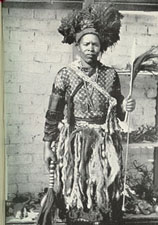 |
Learning The Mbira(27) Introduction | Introductoy History | Mbira Music | The Bira and the N'anga | Constraint and Mobility | Conclusion | End Notes | Bibliography
Considering that mbira music is the music of the ancestors and that it is of central importance in traditional religious ritual, the Shona belief that the spirits play an important role in the process of learning the mbira is not surprising. (Berliner 137)
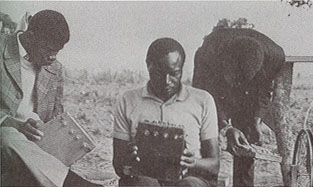 | Berliner learned in his research while in Africa that elders "give what they like" (7). Learning the mbira is not like learning the guitar in America; you cannot go to the local music store, receive lessons, and buy books full of songs. Practice is important to learning the mbira, but inherited skills are crucial. Shona believe that some are meant to play, while others are not. The decision of an elder mbira player to teach a younger one is based heavily on this. Not just anyone can learn to play the mbira. If younger players try to watch over the shoulders of experienced players without their consent, they will sometimes turn their mbira to hide their playing. But looking over the shoulder is also one of the most common ways to learn mbira. Since there is no written music to learn from (all the music is passed down orally), beginners must practice imitating the more experienced. Lately, increases in technology and the emergence of the radio have allowed for students of the mbira to hear and impersonate the masters (Berliner 139). |
Besides learning from peers, Shona attribute the other source of learning the mbira to spirits, through dreams (Berliner 136).(28) Many mbira musicians claim of learning a few pieces by imitation and then learning more from dreams. Michael Gelfand discusses how the traditional Shona healers (n'anga) believe much of their knowledge is given to them in dreams (1964, p.132). Pamela Reynolds goes into even more detail about n'anga, dreams, and Foucault's "techniques of self" (25). The dreams seem to humble the person with knowledge(29) by giving credit for the knowledge to spirits and ancestors. A parallel example is the explaining of special skills with the claim of being possessed by a wandering alien spirit, a shave (Gelfand, 1964, p. 39). While yes, Gelfand is right, explaining special skills with the supernatural keeps people from being different(30), it also gives credit to the ancestors for the knowledge and skills. They are saying that without the work of the ancestors, there is no way they could possess such great skills. How can an mbira player give credit to the pioneers of the music who composed and passed down the songs that the player now uses? They do it by crediting their skill to supernatural spirits. They thank and pay respect to the ancestors by giving them credit for their skills.
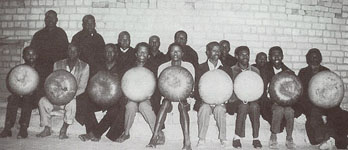
Constraint and Mobility in Shona Society Introduction | Introductoy History | Mbira Music | The Bira and the N'anga | Learning the Mbira | Conclusion | End Notes | Bibliography
With this look at mbira music and Shona society, it is plausible to see how one could come to the conclusion that Shona are anti-progressive and "stuck" in tradition. The repertory of music is extremely traditional, and only the songs that have been played for hundreds of years are allowed at religious ceremonies. It would not be appropriate for a musician to debut his newest composition at a bira. Michael Gelfand, the main published source on Shona culture and society(31), says, "The procedures and conduct of the religious ceremonies are very closely the same wherever I have been, and the type of music played bears a great similarity. The tunes and tempo of the music are the same" (1959, p. 7).
The whole concept of the bira and ancestor worship also support the idea of Shona society being very constraining. Shona do not forget the past; their problems are caused by the past and solved by the past. Ancestors play a huge role in their life. Again Gelfand says:
Every Shona wishes to please his ancestral spirits (vadzimu) and so to live in the same way as they did. It is therefore easy to understand how he becomes hidebound by the customs of his forefathers and afraid to change his habits. Progress is not encouraged. This is one of the factors which accounts for the apparent backwardness of a people which does not believe in change or progress, whether good or bad. (1959, p.8)
Guardian spirits exercise a restraining influence which affects the daily behavior of the Shona. Tradition is treasured by the conservative tribal African and for this 'progressive' opinions and new ideas often encounter great opposition among the older Africans. The vadzimu, they hold, do not encourage their earthly children to strive for progress, and consequently they feel that what was good enough for their grandfathers and grandmothers is good enough for them. The key word to African philosophy is 'normality.' (1964, p. 37)
Is progress really not encouraged? Do Shona really not believe in change? I am not attempting to attack a lame duck, a tourist. Gelfand is "an acknowledged authority in his own field of tropical medicine(32)," author of more than five books about the Shona, is cited four times by Berliner and ten by Reynolds, and spent his life working at the Harare Hospital in Salisbury, Southern Rhodesia(33). Gelfand is neither a tourist nor the exception. While sources are few, when Shona society is discussed, tradition and the past are emphasized. Let it be emphasized that these scholars are not ridiculous or inept. From the background information I provided, it is not hard to see how one could come to those conclusions. But when taking a serious look at the music, I find it impossible to believe that Shona are resistant to change and progress. Their music and society are firmly grounded in tradition and the past, but at the same time, they are constantly changing, evolving, and finding new life. Gelfand asks:
Is it possible to come to any conclusion regarding the chances of survival of this tribal religion? If it is to be judged by the fate of Druidism, Huna, or the ancient Greek and Roman religions, I believe that its prospects are small, and that for each year that passes by less and less of the ritual is being carried out. (1959, p.12).
Shona have persisted through a millennium, and it is still possible to find traces of their ancient society in the music. Is this weakness? Conventional authors are too absorbed with tradition. The tradition is the base of the music and society, and an incredibly strong one at that, but from there, the music is full of individuality, change, and variation.
If attention is called back to the discussion of the nature of mbira music, it will be recalled that mbira music is usually a forty-eight beat, repeated pattern. The music goes on for hours at the bira, so it is cyclical music. Imagine how boring it would be to hear the same forty-eight beat pattern repeated over and over. But mbira music is not boring, and the same pattern is not repeated over and over. Every subsequent time through the pattern, the musician adds personal variations. A little more variation is added each time until the pattern becomes nearly unrecognizable. Looking beyond the learned foundation, the basic pattern, the music is completely improvised. Again a parallel to African American music is incontestable. Jazz music starts out with a basic theme or melody and is followed by the musician improvising off of the structure of the theme. A performance of jazz music is never the same two times; each performance is a completely different entity. The same holds true for mbira music:
In Shona terms, then, an mbira piece such as "Nhemamusasa" is not a single fixed structure with a well-defined beginning and ending. It is rather a set of cyclical, harmonic, and melodic/rhythmic structures, comprising the kernel of a self-contained universe of musical ideas that performers elaborate through variation . . . each performance of a piece is a unique musical event . . . the performance of a composition consists of an ever-changing stream of musical ideas. (Berliner 111)
Is Gelfand listening closely enough when he says that Shona religious music is the same every performance? The Shona even have words for the variations that are added to the kushaura and kutsinhira parts: musaku means variation, zvara means fingerings, madunhurirwai means a speech exaggeration, and miridziro means ways of playing (Berliner 94). If the music was the same every time (as Gelfand claims), the music would be dead. And if the society remained constant, without progress, it would have been dead a long time ago.
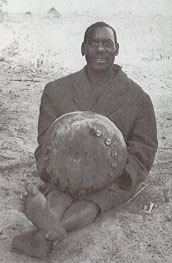 Bandambira Bandambira |
Gelfand writes: "The vadzimu, they hold, do not encourage their earthly children to strive for progress, and consequently they feel that what was good enough for their grandfathers and grandmothers is good enough for them. The key word to African philosophy is 'normality'" (1964, p. 37). But how can this be if the music is so rooted in variation and improvisation? Some jazz players improvise in similar styles, but it is impossible for any two to be the same. Improvisation is incredibly personal and individual; improvisation does not allow for sameness. "The greatest mbira players develop their own styles of performance" (Berliner 152). Players with individual and recognizable styles are the most well known. Berliner points to Mubayiwa Bandambira as an example of a well-known player who achieved notoriety through individuality. Bandambira (from kubanda, which means "to crush") is famous for "the tremendous force with which he hit his mbira keys, especially the bass keys" (153). Does this corroborate with Gelfand's statement that "what was good enough for their grandfathers and grandmothers is good enough for them?" While (as it was previously pointed out) Shona often give credit for special skills to ancestors (spirits), they do not have a desire for sameness. While they continue to pay respect to the past and ancestors, individuality is crucial. |
The buzz that accompanies almost all mbira music gives it another characteristic of distinction. The buzz, although always there, has the nature of always being different. Furthermore, some musicians distinguish their sound by having a very heavy or light buzz. Another aspect of mbira music that gives players original identities is the use of chunings(34). The mbira keys can be easily tuned to a variety of pitches and doing so gives the mbira sound a new flavor. A certain chuning can distinguish one's playing. It gives one's mbira a "special character" and changes its voice (Berliner 62). Some ensembles adopt a certain chuning and create a very personal, recognizable group sound. Berliner adds that "the practice of changing mbira tunings may limit the need for new compositions: when performers tire of the sound of the traditional mbira pieces in one tuning they can adopt another and thereby give their mbira pieces slightly different, fresh characters" (Berliner 87). Forward Kwenda uses different tunings to make his music distinctive. On Svikiro -- Meditations From an Mbira Master, he uses the gandanga (outlaw) tuning(35) and his personal nemakinde tuning to separate himself from "the more common nyamaropa tuning" (Kwenda 3).
Not only is the mbira playing highly individualistic, but the dancing and singing associated with the bira are also starkly in contrast to the traditional view of "Shona sameness." Both dancing and singing are informal ways of participating in a bira. One can enter whenever one wants and is not constricted to any particular style (Berliner 192). The dancing and singing are highly personal: "Many stare into space as if their minds are far away in their own world of expression" (Berliner 193). Where is the constraint and the need to be like others?
A look at the singing in a mapira further bursts the stereotype of constraint and rigidness in Shona society. When a singer utilizes the kudeketera style, they must be quick on their feet since they do not always rely on traditional texts. They often improvise and sing about what is on their mind; this performance is spontaneous and individual. The ability to sing about issues on their mind allows for great mobility: current situations, problems, or issues can be discussed at this "rigid, traditional" bira. Do "'progressive' opinions and new ideas often encounter great opposition(36)," or are they readily accepted in Shona society? Mbira music evolves and adapts to new situations, as shown during colonial rule when mbira music was a symbol of opposition(37). And how can one label Shona society as "anti-progressive" or "too traditional" after looking at the shifts occurring during colonial rule. The Shona did not refuse Christianity, nor did they embrace it wholeheartedly. Instead they fused elements of both; their religion can be described as syncretic: "Even though the majority of Shona people believe in God, virtually all of them still believe their ancestral spirits are their supernatural protectors" (Murungu n.p.).
The indirectness of Shona song, speech, and behavior also lends itself to mobility in the culture. Gelfand discusses "the indirect approach . . . leading to marriage(38)," and Berliner talks about subtlety and the fact that "performers strive to express themselves indirectly at times."(39) Berliner then mentions a couple anecdotes that show problems being solved indirectly(40). He also translates the text of Simon Mashoko's performance on "Mbiriviri" to show the possibilities of indirectness in their songs:
|
Literal Meaning
2. My grandfather was a doctor who gave me a tattoo mark that will last forever.
3. You are leaving the music.
|
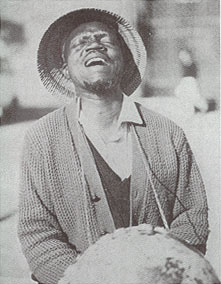
|
Intended Meaning 2. My grandfather was not really a doctor: The tattoo stands for the mbira. The mbira was given to us by our forefathers and with it some things we cannot forget. 3. "Deep Shona": part of our forefathers' words. It does not necessarily refer to someone leaving the music. Perhaps they are scolding someone for not listening carefully or for ignoring the ways of the forefathers. |
What does this indirect expression accomplish? What if "Intended Meaning" were changed to "A Possible Interpretation?" Indirect expression allows for personal interpretation and the possibility for a large number of meanings. There is no "intended meaning," instead, there are millions of meanings. John Kaemmer sees incredible force in their indirectness:
The resistance to European power used music not only as an adjunct to indigenous religious revival but also as a symbol in its own right, particularly as a vehicle for symbolic texts. "The idiomatic Shona of the song texts--deliberate ambiguities, proverbs, the convoluted syntax and pity expressions--were veritable land mines on which the white regime of the day sat with ignorant equanimity."(42) (37)
American society seems so desperate for the one answer, the "right" answer. Americans
want the meaning of a poem, the "correct" reading of a book, and the one solution. The
indirectness and ambiguity of Shona text do not allow for one answer, instead, they allow for
many interpretations. So which is the constraining one and which is the mobile one?
Conclusion
Yes, Michael Gelfand and others, Shona society pays much attention to the past and
ancestors. When illness or problems arise in a Shona family, they consult a traditional healer,
n'anga. When the prescribed medicines, charms, and herbs fail to work, it is then known that the
problem is in the realm of the ancestors. Trying to call attention to some issue, ancestors cause
problems in the family so that they can eventually inform the family of a problem. At a formal, all-night ceremony, known as a bira, mbira music is played through the night to catalyze spirit
possession. Once the host is possessed with the spirit, the problem is talked through with the
villagers and spirit (in body of the host). The mbira serves as the "telephone to the spirits."(43)
The mbira has been estimated to exist in Shona society for the past thousand years. It is a
mystical instrument full of tradition and history. The repertory dates itself back many centuries
and is only passed down orally. The songs, only the traditional ones can be played at mapira, are
cyclical pieces that require variation, distinction, and improvisation to survive. The patterns are
repeated throughout the all-night ceremony but are altered and changed every time through.
Different tunings (chunings), the presence of overtones (multiple pitches with the striking of one
key), interweaving parts (kushaura and kutsinhira), and the buzzing sound (from shells or
bottlecaps) make mbira music not only dense and complex but different every time played.
Individuality is important to mbira players: the most famous are the ones with the most distinct
sound or style.
The singing occurring at mapira also help to illustrate mbira music as free and open. The
kudeketera singing style requires improvisation, and players use what occupies their mind to
occupy their improvised lines. This style makes the music fresh every time and makes the music
reflect the time period. The music is constantly evolving.
The indirectness of Shona behavior and Shona music further breaks the chains of "Shona
as constrained." Shona society is not constraining and rigid; their thinking is not forced to be
done in definitive and restricting terms. The indirectness and ambiguity of their poetry allow for
many meanings and interpretations. This allows the meaning to evolve to fit current events; the
text may be the same, but it is open to new interpretation(44). The prior meanings and history stay
with it, but it is also open for new interpretation. This openness for many interpretations and new
meanings is anything but constraining. Perhaps it is America (the country that is not obsessed
with its past and is always moving forward) that is the constraining society with its need for
absolutes.
Yes, Shona place great value in the past and traditions, but no, Shona are not "hidebound
by the customs of his forefathers and afraid to change his habits."(45) Yes, they revere their
ancestors and play the music of their ancestors, but one is wrong to say, "Progress is not
encouraged" (1959, p. 8). Shona do not live in a bubble; they do not isolate themselves from
surrounding events; they are not stuck in the past. Pamela Reynolds says "systems of knowledge
are always in transformation" (1). A look at the music of the Shona can reveal much about the
nature and values of the society. The music started with the ancestors and has continued to the
present. The pieces are the same, but the song is always changing. There is no "apparent
backwardness" in Shona society, only looks behind the shoulder to see the worn path taken.
Endnotes
Introduction |Introductoy History | Mbira Music | The Bira and the N'anga | Learning the Mbira | Constraint and Mobility | Conclusion | Bibliography
1. How about a look at the current ritalin craze? Children (and college students) who "lack
focus" are given pills to concentrate. Perhaps there are reasons for "lacking focus."
2. Pronounced (em-beera); Berliner, p. 8: mm-bea-ra (r is rolled)
3. Paul Berliner, The Soul of Mbira, Chicago: U of Chicago P, 1978, p. 27.
4. This account draws heavily from Rasmussen, Murray, and Berliner.
5. also spelled Monomotapa.
6. Also called Rozvi; southwestern-based
7. Jocelyn Murray (ed.), Cultural Atlas of Africa, New York: Facts of File, 1981, p. 196.
8. R. Kent Rasmussen and Steven C. Rubert, Historical Dictionary of Zimbabwe (2nd ed.),
London: Scarecrow, 1990, p. xxiv.
9. Rasmussen and Rubert, p. 391.
10. Berliner, p. 16.
11. Solomon Murungu, "Mbira and Shona Spirituality,"Mbira Home Page, 1995,
http://www.tiac.net/users/smurungu/mbira_shona_spirit.html
12. Berliner, p. 9.
13. Roger Lee Randles, "African Group Brings Instrument of Ancestors to Nashville," The
Tennessee Tribune, February 6, 1995, pp PG.
14. Erica Azim with assistance from Forward Kwenda, liner notes, Forward Kwenda: Svikiro --
Meditations From an Mbira Master, Shanachie, 1997, p. 2.
15. Berliner, p. 10-3.
16. Berliner, p. 34.
17. Berliner, p. 34-5.
18. The previous account is widely drawn from Berliner, esp. Chapter 4, "The Nature of Mbira
Music."
19. Four beats to one measure; a quarter note gets one beat. Also called standard time.
20. Also called mahonyera
21. Berliner, p. 115.
22. This account is widely drawn from Berliner, Chapter 8, and Gelfand, Witch Doctor.
23. Berliner, p. 187.
24. Pamela Reynolds: Traditional Healers and Childhood in Zimbabwe. Athens: Ohio UP, 1996,
p. xi: "Until recently, the word was spelled nganga in chiShona orthography."
25. See Reynolds and Michael Gelfand, Witch Doctor, London: Harvill, 1964.
26. Berliner, p. 131-3.
27. This following account is primarily drawn from Berliner, Chapter 6.
28. I find this especially interesting because John Coltrane, one of the best jazz musicians ever,
claimed that his seminal work, A Love Supreme, was divined to him in his dreams. See Eric
Nisenson, Ascension: John Coltrane and his Quest.
29. Although Berliner points out that those who learn with dreams are given a certain prestige
(138).
30. Gelfand, 1964, p. 41.
31. Gelfand's four books on Shona culture, society, history, and tradition are some of the only
books available on this topic. D.N. Beach covers Shona history, but Gelfand is the primary
source for Shona culture and society.
32. Gelfand, 1962. M. Hannan, S.J., Foreword.
33. Gelfand, 1962, title page. Also note: Southern Rhodesia is now Zimbabwe (since 1980) and
Salisbury is now Harare.
34. Berliner describes the word as Shona-ized English, p. 61.
35. Also known as mavembe (people with speech defects) tuning.
36. Gelfand, 1964, p. 37.
37. See John E. Kaemmer, "Social Power and Music Change Among the Shona,"
Ethnomusicology, Winter 1989, p. 37.
38. Gelfand, 1964, p. 22.
39. Berliner, p. 177.
40. See pages 177-181.
41. Berliner, p. 166.
42. Kaemmer cites Alec J.C. Pongweni, Songs that Won the Liberation War, Harare: The College
Press, 1982, Preface.
43. Kwenda, p. 1.
44. Wasn't this the intention of America's greatest document, the Constitution? It was purposely
written with vague wording to assure that it never out-dated itself.
45. Gelfand, 1959, p. 8.